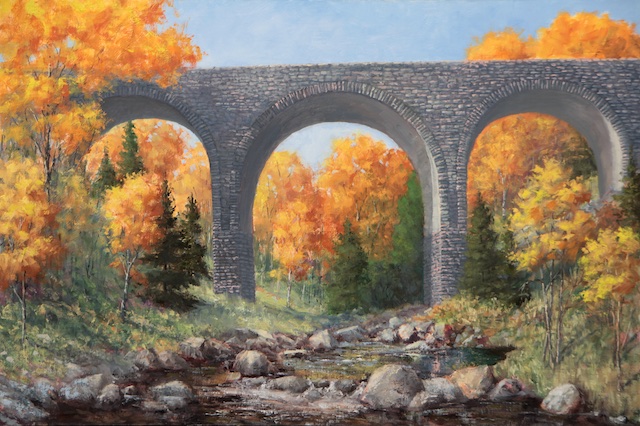It was just last year that a woman from Georgia contacted painter Robert Hagberg with regard to possibly commissioning a painting. But it’s the story that unfolded after hat you’ll find especially interesting.
The beginning of our story dates to the early 1950s, when the Duck Brook Motor Bridge on Paradise Hill Road was constructed in Acadia National Park in Maine. It was a project that had been delayed by World War II, but was eventually completed through the Bureau of Public Roads. That was about 63 years ago.
Heading the building of the bridge was M&M Construction Company, which was supervised by Avon Robert Klotz. Significantly, Klotz is the father of Therese Marshall, the woman who had contacted Hagberg about a painting. Marshall was familiar with Hagberg’s painting and had purchased his painting of Bar Harbor at Argosy Gallery years before. For the Klotz family, especially Therese, the bridge was something of an icon. Growing up, she and her family would drive by “Dad’s Bridge” to observe progress of construction. “It was easy for me to understand the special meaning this landmark had for Therese,” says Hagberg. “I felt a sense of honor to be asked to paint it for her.”
Although Theresa provided Hagberg with photos of the bridge in construction, her father in uniform, and a recent view, the artist had a much better idea: en plein air. As coincidence would have it, Hagberg was already planning a painting excursion to Acadia in August. With Therese’s blessing, Hagberg had a date with a bridge. “I went to Acadia National Park expecting to have an enjoyable afternoon of painting which would provide me with the studies and photos I would need for a studio painting,” says Hagberg.
“There are two roads that parallel each other,” Hagberg continues, “One is Route 3 or Eden Street and the other Paradise Hill Road. It was Route 3 that Therese and her family would travel to view the evolving bridge. When I traveled Route 3, I realized there was a problem: I could not see a bridge anywhere on the parallel road. I finally had to take Paradise Hill Road until I got to the bridge and hike down to the brook, which was the vantage point from which the old photos were taken. This first picture, below, is what I saw.”

Certainly a nice landscape view, but the main character is obscured!
“I was on to plan B,” Hagberg continues. “After getting back home, I researched the bridge at the Library of Congress and found two photo references I could use. I did some preliminary pencil sketches that I submitted to Therese for her input. We arrived at a consensus on an image that we both liked. Then the real work began.
“I had to rely on my understanding of running brooks, architectural perspective, sunlight and shadows, and the trees and foliage of the area. To that knowledge, I added all the skills I have learned and developed from years of plein air and studio painting, to create an image that was true to the structure of the bridge and the nature around it.
Delivery of the painting, however, is not the end of this story. “Therese is on a quest to have the Park Service clear the forest growth to enable people to once again see the beauty of the bridge her father was instrumental in realizing,” Hagberg says. “She created a website, theforgottenbridgeofacadia.org, to provide people with the history of the bridge and her family’s connection to it, as well as a petition to encourage the Park Service. Therese makes regular trips to Maine to speak to civic groups, to tell her story and encourage people to support her cause.
“I am honored to have my painting help in this cause as a representation of what could be seen by the millions of people who drive by this bridge every year on their way to Acadia National Park. Its beautiful pink granite facade and high arches over the trickling brook would be a gorgeous scene and a great location for the Fall Color Week paint-out.”




